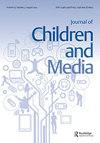Roadblocks and resistance: Digital mediation as a process of calibration among U.S. parents of adolescents
IF 2.1
3区 心理学
Q2 COMMUNICATION
引用次数: 0
Abstract
ABSTRACT Research in parental mediation often focuses on how parents’ practices for managing digital media are aligned with normative expectations. However, there is less research that explores parental mediation as a process, with practices changing over time in response to barriers and challenges. To address this gap, the goal of the current study is to examine parents’ decisions around not monitoring or limiting adolescents’ media use. Based on focus group discussions and interviews with predominantly female (77%) and White (92%) parents living in five communities in the Midwestern United States, we explore parental mediation as a process in which decisions about children’s media use reflect competing individual, ideological, and structural factors. In eight focus groups (n = 48) and 13 follow-up interviews, we ask parents to narrate barriers to commonly suggested mediation strategies to examine how parents’ navigate factors such as efficacy, conflict, or adolescent autonomy in managing digital media use. Based on the findings, we propose that looking at barriers illustrates mediation as a process of calibration, a decision that is made and re-made as parents navigate complex and sometimes contradictory situations and expectations. IMPACT SUMMARY Prior State of Knowledge: Past studies on parental mediation of digital technology define a range of strategies like restriction or monitoring and explore factors predicting whether parents use these strategies. Less research examines how parents arrive at the decision to implement normative mediation strategies. Novel Contributions: We propose the term calibration to explain how barriers and challenges prompt shifts in parental mediation over time. Calibration captures how parents balance competing internal and external factors, like efficacy or norms, in engaging with adolescents about digital media use. Practical Implications: Conceptualizing mediation as calibration may help parents develop a toolbox of strategies that can shift as needed. In addition, focusing on values like autonomy helps parents choose which mediation strategies work for their family context and which may not.障碍与阻力:美国青少年父母的数字调解校准过程
父母调解的研究通常集中在父母管理数字媒体的实践如何与规范期望保持一致。然而,很少有研究将父母调解作为一个过程来探索,随着时间的推移,实践会随着障碍和挑战而改变。为了解决这一差距,当前研究的目标是检查父母在不监控或限制青少年使用媒体方面的决定。基于焦点小组讨论和对生活在美国中西部五个社区的主要女性(77%)和白人(92%)父母的访谈,我们探讨了父母调解作为一个过程,在这个过程中,关于儿童媒体使用的决定反映了相互竞争的个人、意识形态和结构因素。在8个焦点小组(n = 48)和13个后续访谈中,我们要求父母叙述通常建议的调解策略的障碍,以检查父母如何在管理数字媒体使用方面导航诸如有效性,冲突或青少年自主权等因素。基于这些发现,我们提出,对障碍的观察说明了调解是一个校准的过程,是一个在父母应对复杂的、有时是矛盾的情况和期望时做出和重新做出的决定。以往对数字技术父母中介的研究定义了一系列的策略,如限制或监控,并探讨了预测父母是否使用这些策略的因素。较少的研究探讨了父母如何决定实施规范的调解策略。新颖贡献:我们提出术语校准来解释障碍和挑战如何促使父母调解随时间的变化。校准记录了父母在与青少年讨论数字媒体使用时如何平衡相互竞争的内部和外部因素,如有效性或规范。实际意义:将调解概念化为校准可以帮助父母开发一个策略工具箱,可以根据需要进行转换。此外,关注自主权等价值观可以帮助父母选择哪种调解策略适合他们的家庭环境,哪些可能不适合。
本文章由计算机程序翻译,如有差异,请以英文原文为准。
求助全文
约1分钟内获得全文
求助全文

 求助内容:
求助内容: 应助结果提醒方式:
应助结果提醒方式:


